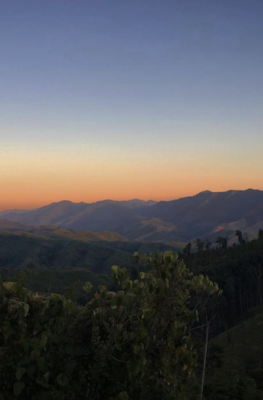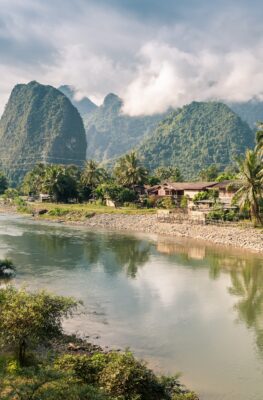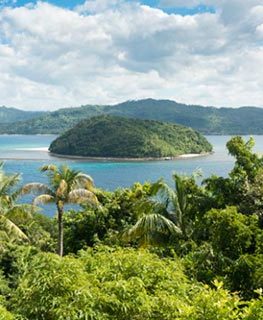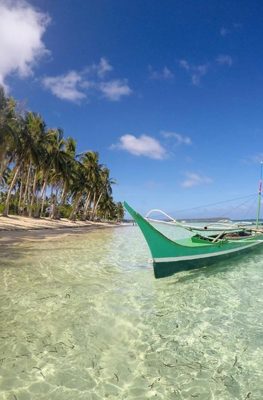Published on January 21, 2010
Luang Prabang, considered one of the best preserved towns in Southeast Asia, and inscribed on the UNESCO World Heritage List in 1995, presents loads of historic, cultural and natural attractions, many of which can be accessed by foot, bicycle, tuk-tuk and even electrically boosted bikes.
Luang Prabang straddles a 1-km peninsulaat the confluence of the Nam Khan and Mekong Rivers and retains its small-town charm with a mix of traditional wood–and-bamboo houses, French colonial architecture, and gold-topped temples.
King Fa Ngum, 14th century founder of the Lane Xang kingdom, established himself in the capital Luang Prabang. Locals called it Muang Xieng Dong-Xieng Thong, but when the Khmer monarchy presented the king with a golden Buddha image, Pha Bang, he renamed the city Luang Prabang. Though the capital moved to Vientiane in 1545, the city remains Laos’ spiritual hub.
Observing or participating in Binthabatt is a must when visiting Luang Prabang. In this solemn early morning ceremony, monks walk through town carrying alms bowls into which people place sticky rice, fruit or traditional snacks to make merit.
This presents a good start for visiting Luang Prabang’s ancient temples.And at the top of that list is Vat Xiengthong, built around 1560. This classic example of Lane Xang architecture features a gracefully sloping roof and glass murals.
Originally erected in 1512,the city’s oldest temple Vat Visounarath presents carved wooden window frames and ancient statues, and Vat Manolom houses the Laos’ oldest Buddha image, created in 1379. Another temple, originally called Vat Mai, was built in 1796 and renamed Vat Mai Suwannaphummaham after its 1821 restoration, the temple is notable for its four-tiered roof and scenes from daily life, as well as the legend of Vessantara on the bas-relief walls.
Other temples of note are Vat That Luang built on a knoll in 1818 behind the old stadium; Vat Sene, constructed in 1718, houses longboats for the annual Mekong Boat Racing Festival in early October; and the hilltop Vat Chomphet, built in 1888, offers stunning views of Luang Prabang and the Mekong.
To visit the 20-meter-tall Vat Chomsi Stupa, climb 328 steps to the top of Mount Phousi, which offers a superb sunset view, and don’t miss the National Museum, which houses Pha Bang, religious artifacts, and gifts from foreign envoys including a moon rock.
Popular natural attractions near town include the Kuang Si and cascading Tad Sae Waterfalls, where you can swim and picnic, and Pak Ou Cave’s 5,000 Buddha images at the confluence of the Mekong and Nam Ou Rivers.
Interested in sampling local cuisine? Most restaurants serve aur lam (a thick stew of forest herbs, meat and Lao eggplant), jaew bong hot chili and buffalo skin sauce, and khai pan (lightly fried river weed with sesame seeds and garlic).
Shoppers can find handicrafts like hand-woven textiles, silver, wood carvings and mulberry paper at the Night Market and the Handicraft Market. For distinctive artwork and textiles, visit more upscale galleries such as Ock Pop Tok and Caruso Lao Home Craft.
How about a village visit? Ban Phanom women work on looms, Ban Xieng Mene glimpses into traditional Lao village life, and Ban Xieng Lek villagers make posa paper from mulberry bark. Traditional pottery-making village, Ban Chan, is a 15-minute boat ride from town, and to sample Lao Lao (homemade alcohol) stop at Ban Xang Hai on the way to Pak Ou Cave.
Community-based tourism programs led by trained provincial and village guides offer authentic experiences and ensure the villages visited benefit from the fees paid.
The 4- to 5-hour Kwang Si Waterfall Walk presents a trail to the falls, and stops at Hmong and Khamu villages. The challenging two-day Chomphet Trek and Home Stay explores Luang Prabang’s mountain life at Hmong, Khmu and lowland Lao villages, and the two-day Muang Ngoi Trek follows the Ou River and includes an overnight stay in a Khmu village guesthouse.
For information on these tours, contact the Provincial Tourism Office Luang Prabang or visit www.ecotourismlaos.com.
Vientiane-based Bernie Rosenbloom writes for TTG Asia, PATA Compass, and EcotourismLaos.com; and he co-authored The Responsible Tourism Guide to Cambodia, Laos and Vietnam.






